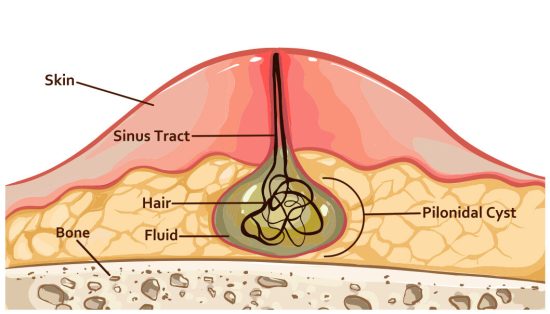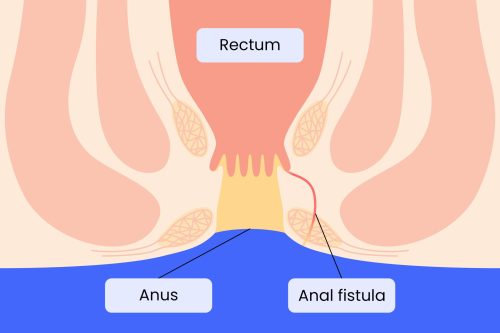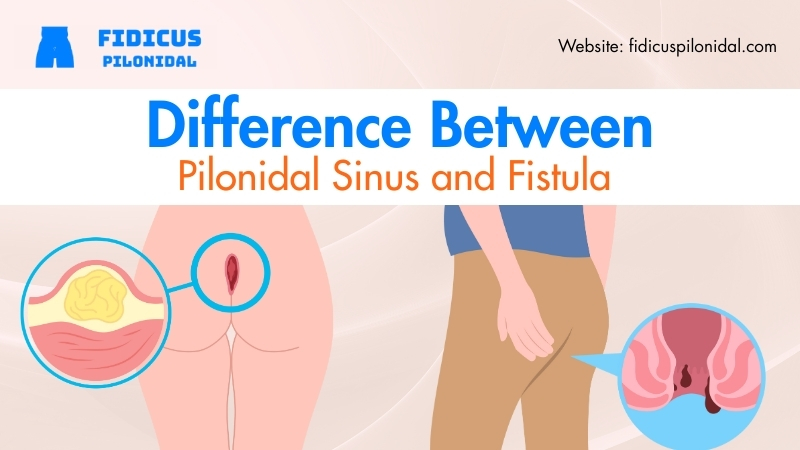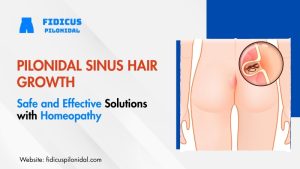Pilonidal sinus and anal fistula are two different conditions, but many people confuse them because both involve infection, pus discharge, and discomfort. A pilonidal sinus usually develops near the tailbone, where hair and dead skin get trapped under the skin, leading to swelling, abscesses, and repeated infections. On the other hand, an anal fistula forms around the anal canal, often after a previous abscess, and creates an abnormal passage between the anal gland and skin, causing pain, pus, and sometimes bleeding.
While surgery is commonly suggested for both conditions, recurrence rates remain high. This is where homeopathy treatment plays a vital role. Homeopathic medicines work by improving immunity, controlling infection, reducing pus formation, and healing the tract naturally without invasive procedures. At our homeopathy clinic in Hyderabad, we specialize in treating both pilonidal sinus and anal fistula with safe, non-surgical methods that focus on long-term relief and prevention of recurrence.
What is Pilonidal Sinus?
A pilonidal sinus (PNS) is a chronic skin condition that usually develops in the natal cleft (the groove just above the buttocks, near the tailbone). The word pilonidal comes from the Latin words pilus (hair) and nidus (nest), meaning a “nest of hair.” This is because the sinus cavity often contains loose hair, sweat, debris, and dead skin cells, which gradually burrow into the skin. Over time, these trapped materials cause irritation, inflammation, and infection, resulting in abscess formation or a draining sinus tract.
Key Facts about Pilonidal Sinus
- Most common in young adults between the ages of 15 and 35 years, particularly during the most active phase of hair growth.
- Men are affected more often than women because of thicker and coarser body hair.
- People with sedentary lifestyles or those who sit for prolonged periods (e.g., drivers, IT professionals, students) are at greater risk due to pressure and friction in the buttock cleft.
- It is often seen in individuals with obesity, excessive sweating, or poor hygiene, all of which increase the chances of bacterial infection.

Causes of Pilonidal Sinus
The exact cause of pilonidal sinus is not entirely understood, but most experts believe it develops due to a combination of mechanical friction, hair growth, skin debris, and bacterial infection. The condition usually begins when loose hair and dead skin penetrate the skin of the buttock cleft, triggering an inflammatory reaction. Over time, this leads to abscess or sinus tract formation.
- Ingrown Hair
Loose or broken hairs shed from the body get trapped in the buttock cleft. Continuous friction causes the hairs to burrow into the skin, leading to irritation, foreign-body reaction, and eventually a sinus. - Prolonged Sitting
People with desk jobs, drivers, IT professionals, and students are particularly prone because long sitting increases pressure and sweating in the natal cleft. - Sweating & Poor Hygiene
Excessive sweating creates a warm, moist environment in the buttock crease, encouraging bacterial growth. - Obesity Overweight individuals often have a deeper and narrower natal cleft, which collects more hair, sweat, and debris.
Symptoms of Pilonidal Sinus
The symptoms of pilonidal sinus vary depending on whether the sinus is inactive (dormant), acutely infected, or has become chronic with recurrent tracts. Some people may have only a small skin dimple without pain, while others experience repeated abscesses and constant discharge.
Common Symptoms
- Small dimple-like opening at the top of the buttock cleft (often the first visible sign).
- Painful swelling or lump near the tailbone that worsens while sitting, walking, or bending.
- Redness, warmth, and tenderness in the affected area, especially during infection.
- Pus or blood discharge from the sinus opening, often with a foul smell due to bacterial growth.
- Recurrent abscess formation – swelling subsides after pus drains but keeps coming back.
What is an Anal Fistula?
An anal fistula is a chronic abnormal tunnel that connects the anal canal to the skin around the anus. It usually develops after an anal abscess that does not heal properly, leading to persistent infection, pus discharge, and discomfort. Unlike a pilonidal sinus, which occurs near the tailbone, an anal fistula is directly associated with anal glands and rectal infections. The condition rarely heals on its own and may become recurrent if not treated effectively.
- Usually develops after an anal abscess that fails to heal properly.
- It is a persistent condition and rarely heals without medical or surgical treatment.
- Fistula can be simple (single tract) or complex (multiple tracts).

Causes of Anal Fistula
An anal fistula usually develops when the anal glands become infected and blocked, leading to pus formation and tunnel-like tracts between the anus and the skin. If left untreated, the infection often becomes chronic, resulting in a persistent fistula.
- Previous anal abscess – most fistulas develop after an abscess drains incompletely.
- Chronic infections – tuberculosis, sexually transmitted infections, or trauma.
- Crohn’s disease – patients with inflammatory bowel disease are prone to recurrent fistulas.
- Radiation therapy – tissue damage in the rectal region may trigger fistula formation.
- Post-surgical complication – after anorectal surgery in some cases.
Symptoms of Anal Fistula
The symptoms of an anal fistula are usually more severe and troublesome compared to a pilonidal sinus. Since it is directly connected to the anal canal and digestive system, it tends to cause persistent discomfort, repeated infections, and discharge. Patients often experience a cycle of abscess formation, drainage, and recurrence, which affects their daily routine and overall quality of life.
- Persistent or intermittent pus discharge near anus
- Pain during bowel movements or sitting
- Swelling and redness around anus
- Bleeding or foul-smelling discharge
- Fever, fatigue, or chills in case of abscess
- Recurrent perianal abscesses despite treatment
Unlike pilonidal sinus, anal fistula is closely linked to the digestive system and needs specialized care.
Differences Between Pilonidal Sinus and Anal Fistula
Although both pilonidal sinus and anal fistula involve pus discharge, infection, and discomfort in the lower back or anal region, they are entirely different conditions. A pilonidal sinus develops in the upper part of the buttock cleft, near the tailbone, while an anal fistula forms around or near the anus and connects the anal canal to the external skin. The cause of pilonidal sinus is usually the penetration of loose hair into the skin due to friction, poor hygiene, or prolonged sitting, whereas an anal fistula commonly develops after an infection of the anal glands, often following an abscess or in association with Crohn’s disease.
Homeopathy Treatment of Pilonidal Disease
Conventional treatment for pilonidal sinus often involves incision, drainage, or surgery. However, recurrence rates remain high even after surgical excision. This is where homeopathy treatment for pilonidal sinus offers a natural, safe, and long-lasting alternative.
Benefits of Homeopathy for Pilonidal Sinus
- Treats the root cause by reducing infection and inflammation.
- Non-surgical approach – no stitches, no long recovery time.
- Prevents recurrence by strengthening immunity and skin healing.
- Remedies are chosen based on individual symptoms and constitution.
- Effective for both acute abscess and chronic sinus cases.
Popular Homeopathic Remedies (as prescribed by doctors)
- Silicea – for recurrent pus discharge and slow healing.
- Hepar Sulphur – for painful, inflamed abscess with pus.
- Myristica Sebifera – for faster drainage of pus and prevention of complications.
- Calcarea Sulphurica – for chronic discharges with foul smell.
At Fidicus Pilonidal, Hyderabad, our experienced homeopathy doctors for pilonidal sinus provide customized treatment plans, combining remedies with lifestyle guidance such as:
- Regular hair removal in the cleft area
- Maintaining hygiene and dryness
- Avoiding long hours of sitting
- Weight management and proper nutrition

Final Thoughts
Both pilonidal sinus and anal fistula cause discomfort, pus discharge, and recurrent infections, but they differ in their location, cause, and treatment. While anal fistula usually requires surgical procedures, pilonidal sinus can be managed effectively with homeopathy, avoiding surgery and reducing recurrence.
If you are looking for pilonidal sinus treatment in Hyderabad, Fidicus Pilonidal offers safe, personalized, and effective homeopathy treatment for pilonidal sinus to help you recover naturally and prevent future episodes.






